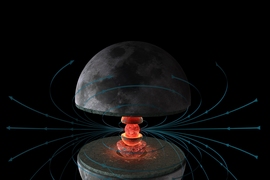When the Apollo astronauts returned to Earth, they brought with them some souvenirs: rocks, pebbles, and dust from the moon’s surface. These lunar samples have since been analyzed for clues to the moon’s past. One outstanding question has been whether the moon was once a complex, layered, and differentiated body, like the Earth is today, or an unheated relic of the early solar system, like most asteroids.
Ben Weiss, a professor of planetary sciences in MIT’s Department of Earth, Atmospheric and Planetary Sciences, and members of his laboratory have found remnants of magnetization in some lunar rocks, suggesting that the moon once emitted a substantial magnetic field, much like the Earth does today. The discovery has opened a new set of questions: How long did this magnetic field last? How strong was its pull? And what sparked and sustained it?
Weiss and former MIT student Sonia Tikoo have written a review, published today in Science, in which they explore the possibility of a lunar dynamo — a molten, churning core at the center of the moon that may have powered an intense magnetic field for at least 1 billion years. Weiss spoke with MIT News about the moon’s hidden history.
Q. How would a lunar dynamo have worked? What might have been going on in the moon, and in the solar system, to sustain this dynamo for a billion years?
A. Planetary dynamos are generated by the process of induction, in which the energy of turbulent, conducting fluids is transformed into a magnetic field. Magnetic fields are one of the very few outward manifestations of the extremely energetic fluid motions that can occur in advecting planetary cores.
The motion of Earth’s liquid core is powered by the cooling of the planet, which stirs up buoyant fluid from the surrounding liquid — similar to what happens in a lava lamp. We have recently argued from magnetic studies of Apollo samples that the moon also generated a dynamo in its molten metal core.
Our data suggest that, despite the moon’s tiny size — only 1 percent of the Earth’s mass — its dynamo was surprisingly intense (stronger than Earth’s field today) and long-lived, persisting from at least 4.2 billion years ago until at least 3.56 billion years ago. This period, which overlaps the early epoch of intense solar system-wide meteoroid bombardment and coincides with the oldest known records of life on Earth, comes just before our earliest evidence of the Earth’s dynamo.
Q. Why is it so surprising that a lunar dynamo may have been so intense and long-lived?
A. Both the strong intensity and long duration of lunar fields are surprising because of the moon’s small size. Convection, which is thought to power all known dynamos in the solar system today, is predicted to produce surface magnetic fields on the moon at least 10 times weaker than what we observe recorded in ancient lunar rocks.
Nevertheless, a convective dynamo powered by crystallization of an inner core could potentially sustain a lunar magnetic field for billions of years. An exotic dynamo mechanism that could explain the moon’s strong field intensity is that the core was stirred by motion of the solid overlying mantle, analogous to a blender. The moon’s mantle was moving because its spin axis is precessing, or wobbling, and such motion was more vigorous billions of years ago, when the moon was closer to the Earth. Such mechanical dynamos are not known for any other planetary body, making the moon a fascinating natural physics laboratory.
Q. What questions will the next phase of lunar dynamo research seek to address?
A. We know that the moon’s field declined precipitously between 3.56 billion years ago and 3.3 billion years ago, but we still do not know when the dynamo actually ceased. Establishing this will be a key goal of the next phase of lunar magnetic studies.
We also do not know the absolute direction of the lunar field, since all of our samples were unoriented rocks from the regolith — the fragmental layer produced by impacts on the lunar surface. If we could find a sample whose original orientation is known, we could determine the absolute direction of the lunar field relative to the planetary surface. This transformative measurement would then allow us to test ideas that the moon’s spin pole wandered in time across the planetary surface, possibly due to large impacts.










